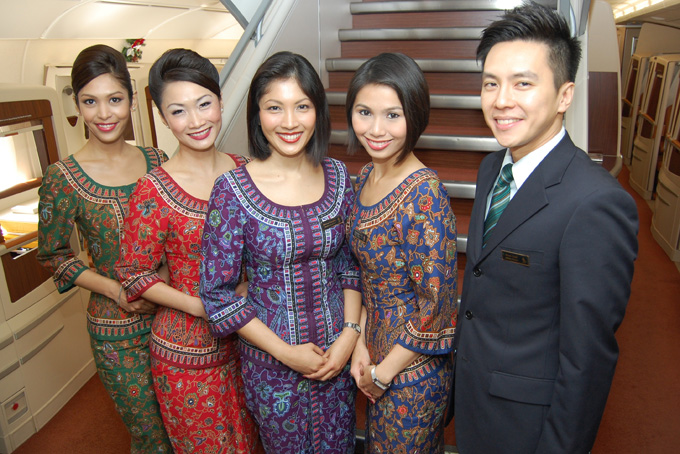
FLIGHT ATTENDANTS–Singapore Airlines’ iconic Singapore Girl first appeared in 1972 wearing the “sarong kabaya” uniform, inspired by traditional attire found across much of Southeast Asia. (Photo/Singapore Airlines).
by Ramy Inocencio in Hong Kong and Frances Cha in Seoul
(CNN) — Images of bikini-clad women in Thailand posing suggestively in an online ad for a local airline inflamed passions — both positive and negative — earlier this year.
Domestic low-cost carrier Nok Air stood at the center of the frenzy. The airline had employed the provocatively clothed women to attract more attention in a Facebook publicity move.
It worked.
“I kind of expected it to be fairly controversial, but at the end of the day more people ended up liking it than hating it,” says Patee Sarasin, Nok Air’s chief executive officer.
“When it debuted on Facebook, we had over 200,000 likes. I’m happy.”
The campaign proved to be a social media success — it also brought into focus the different ways international airlines use the attractiveness of cabin crews to brand and market their product.
Though acknowledging that “beautiful does not equate to being a good flight attendant,” Ji Yang Xiong, director of China’s Foreign Airlines Service Corporation, notes a difference in aesthetics when comparing airlines from the East and West.
“Maybe Asian airlines emphasize looks just a bit more when compared to European or Middle Eastern airlines,” says Xiong. “European airlines don’t have any requirement on looks. They mostly focus on personality and having the right attitude for the job and a service-oriented mindset.”
Legal issues: Grounded at 30?
While some Asia-based airlines openly embrace glamour in the cabin, most U.S. and European airlines long ago altered such strategies to reflect shifting social standards and more severe legal restrictions.
“It’s one thing to be able to help people out of an emergency exit door, it’s another to say they must weigh less than 130 pounds, as Pan Am and others might have done in times gone by,” says Kenneth Quinn, partner and head of aviation practice at the Washington, D.C.-based law firm Pillsbury Winthrop.
“Most governments have enacted laws and other protective measures against gender and age discrimination, as well as fitness discrimination,” says Quinn. “But Asian countries have less precise formulas in their labor laws that permit airlines to impose age and appearance limitations upon flight crews.”
In addition, says Quinn, governmental bodies in Asia are generally less committed to regulatory oversight in this area.
“They try to leave it to the airlines and unions and work forces to deal with any problems,” he says. “Certainly weight and appearance limitations tend to be not strictly enforced.”
“Laws covering employment and particularly discrimination tend to be less rigid in Asia,” agrees Tom Ballantyne, aviation expert and chief correspondent for Hong Kong-based “Orient Aviation” magazine.
“A British Airways or a Qantas in Western society would never get away with promoting the sort of image that, for instance, Singapore has always done with its Singapore Girls.”
Nok Air has no flight attendants over the age of 30, says CEO Sarasin. While laws in the West protect against discrimination, “it is kosher here in Asia to push youth and beauty,” he says.
The lifespan of a Nok Air flight attendant is short, according to Sarasin.
They typically take to the skies from graduation around the age of 23, stay in the company for three years — maybe another two if they’re “really, really good” — then can move to non-cabin crew departments or get help with being placed with other airlines.
“We keep them young — not because we’re sexist — but because our customers prefer younger crews,” says Sarasin. While “everyone is unionized in the United States, we are much more open. That’s what gives Asia the magic. We’ve been radical from day one, differentiating our marketing. If we don’t, we die.”
Profits: No link between beauty, bottom line?
The jury is still out on whether sex sells more seats.
“I’ve never seen any evidence that directly links the beauty of flight attendants to the bottom line,” says Ballantyne. “Certainly it is true that many airlines in Asia-Pacific, especially low-cost operators, base part of their brand image on young, attractive flight attendants. How that translates to additional passenger numbers I’m not sure.”
“I’d say it’s impossible to put a monetary value to the contribution of the Singapore Girl to Singapore Airlines’ success over the years,” agrees Nicholas Ionides, spokesman for legacy carrier Singapore Airlines, referring to the well known imagery of the company’s female flight attendants — conceived in 1972 — wearing distinctive “sarong kabaya” uniforms.
Nok Air’s Sarasin himself hedges on whether his company’s Facebook stunt helped pull in more profits.
“It’s hard to measure if it boosts sales or not,” he says. “Load factor (the number of seats sold for flights) has always been in the 80 to 90 % range. But it did bring Nok Air into the limelight in terms of brand awareness.”
If anything, the charismatic CEO believes the added publicity brought a change to the passenger mix.
Before the photo shoot, international travelers made up 10 percent of the passenger manifest. After the shoot, the percentage jumped to 18 percent based on passport checks.
With Nok Air set to make its first international flight — to Yangon, Myanmar, in the third quarter of 2013 — Sarasin says: “It’s good timing.”
Offensive: Is “sexy” a bad word?